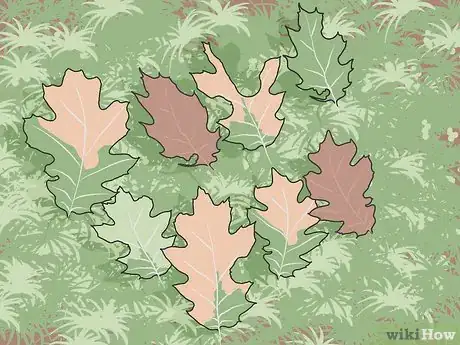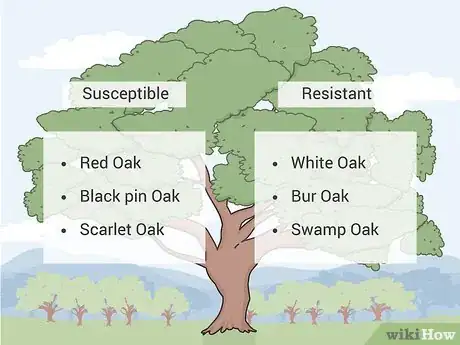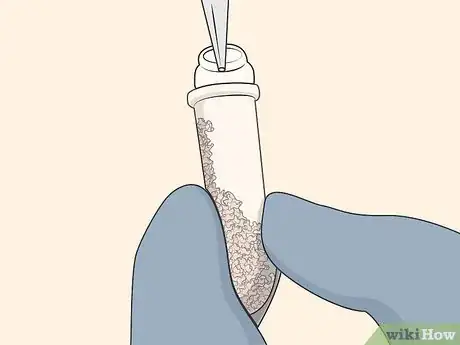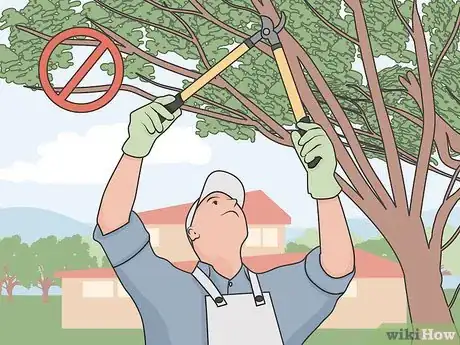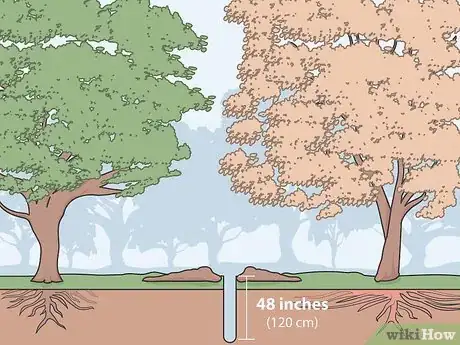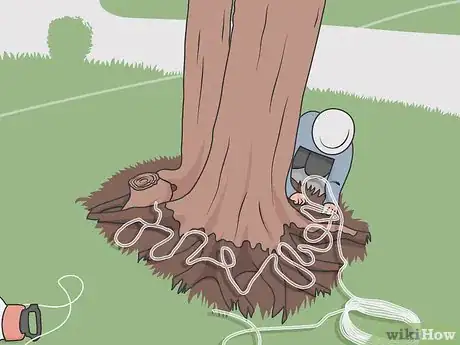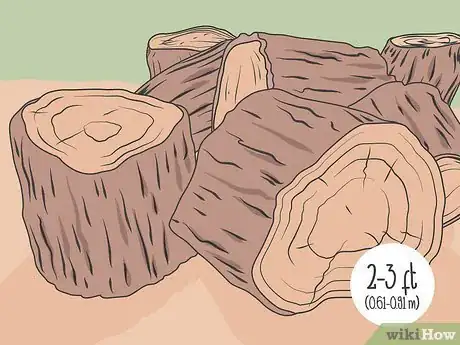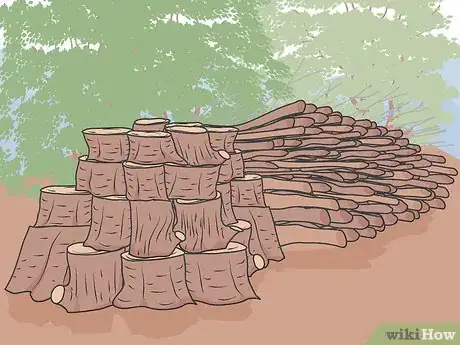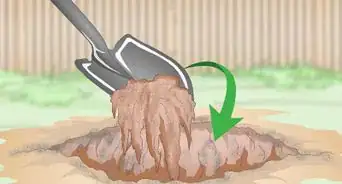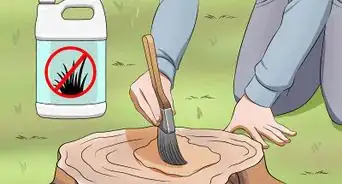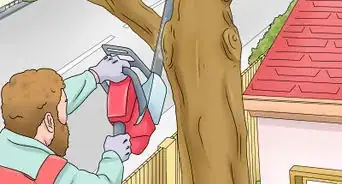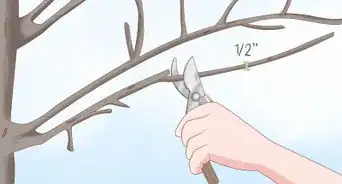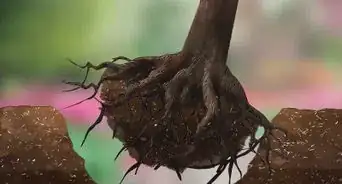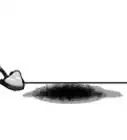This article was co-authored by Lauren Kurtz. Lauren Kurtz is a Naturalist and Horticultural Specialist. Lauren has worked for Aurora, Colorado managing the Water-Wise Garden at Aurora Municipal Center for the Water Conservation Department. She earned a BA in Environmental and Sustainability Studies from Western Michigan University in 2014.
This article has been viewed 10,222 times.
Oak wilt is an aggressive fungal disease that affects all species of oaks, though Red Oaks are especially vulnerable. The fungus prevents water and nutrients from traveling throughout the tree by infecting its vascular system. If left untreated, it can kill a healthy tree within a few months and leave nearby specimens vulnerable to infection. While there’s no way to save an oak once it’s in the grips of the disease, there are a few steps you can take to stem the spread in your yard or garden. These include injecting infected oaks with slow-acting fungicides, preventing contact between neighboring trees, and destroying a tree entirely once it succumbs to the infection.
Steps
Identifying Common Symptoms
-
1Look for odd or discolored foliage. Oak wilt usually shows itself among the growth in the canopy (roughly the upper third of the tree) first. If the leaves have an oily sheen to them or appear to be taking on an unseasonal red, brown, or yellow tint around the veins or edges, there’s a chance that the tree is infected.
- Examine freshly-fallen leaves to get a closer look.
- As the name suggests, oak wilt can also sometimes cause the leaves of seemingly healthy specimens to wilt, curl, or wither. However, color is often the better indicator, as wilting frequently has a wide range of possible causes.
-
2Take note if your oak begins shedding leaves unexpectedly. Trees stricken with oak wilt will often drop large numbers of both green and discolored leaves, even during warmer months when they should be thriving. It’s normal for oak trees to lose a few leaves here and there, but major defoliation can point to a much more serious problem.[1]
- Try not to mistake seasonal thinning for defoliation—many species of oaks shed their leaves in late winter or early spring to make room for new growth.[2]
Advertisement -
3Learn which varieties of oak are most susceptible to wilt. While oak wilt can occur in any species, it’s most common in red, black pin, and scarlet oaks, which have fewer natural defenses for the disease. These specimens should be monitored closely during all seasons and, if necessary, treated or removed to keep them from becoming a threat.[3]
- By contrast, trees in the white oak family, including white, bur, and swamp oaks, are more resistant to wilt. As a result, it may take longer for these species to manifest symptoms.
- In the event that one of your trees begins displaying symptoms of oak wilt, treating or removing it immediately will reduce the risk of the disease making its way throughout your yard or garden.
-
4Submit a tissue sample to confirm oak wilt. Just because a tree displays symptoms characteristic of oak wilt doesn't mean it's infected. In order to find out for sure, it will be necessary to have wood from the tree you suspect of being diseased tested by a qualified arborist or tree disease expert. Once they've examined the sample, they'll be able to confirm whether or not the tree has fallen victim to oak wilt.[4]
- Since the fungal spores that cause oak wilt are invisible to the naked eye, there's no way to tell beyond a shadow of a doubt whether a given tree is infected outside of a laboratory setting.
- Tissue sample tests aren't always 100% accurate. In some cases, the results may come back negative because the disease hasn't yet spread to the part of the tree the sample was taken from.[5]
Controlling the Spread of Oak Wilt
-
1Avoid pruning trees that show signs of infection. Cutting back diseased trees leaves behind open wounds that can easily hasten the spread of oak wilt. The resulting sap leakage may also attract insects like beetles that feed on oaks. As these scavengers migrate to other trees, they’ll carry the harmful fungal spores with them.
- Don't prune your trees during the winter through early-mid summer (between February 15 and June 15 in the US). This is when feeding beetles tend to be most active.[6]
- Always sanitize your gardening implements thoroughly before and after pruning a tree with oak wilt.
- If you simply must prune an infected tree, or you’ve already done so unknowingly, brush the cut section with a layer of wound sealant or latex paint to close it off.
- If you must prune during winter through early-mid summer, you should use a wound sealant paint even on uninfected trees, as this will prevent beetles that carry the fungus from feeding on the sap. This is especially important if you live in an area where you know there are infected trees.
-
2Cover cut oak stumps with a thick layer of plastic. If you’ve cut down a diseased tree but aren’t able to grind the stump right away, drape a roll of plastic sheeting over the exposed base and bury the edges underground. The plastic will serve as a protective shield to keep fungal spores trapped and prevent them from finding their way to other trees.[7]
- The plastic cover should remain in place until either you uproot and chip the stump or it’s had enough time to rot naturally.
-
3Try trenching to cut off at-risk trees. Trenching involves creating a buffer zone between healthy and infected trees. This prevents the fungus from spreading from one tree to another through root grafts. Use a rock saw, ditching machine, or backhoe to cut deep enough into the soil to sever the root connection. Oaks put down deep roots, so you’ll need to dig pretty deep (at least 48 inches (120 cm), in most cases) in order to reach them.[8]
- You can typically rent heavy digging equipment like ditching machines and backhoes by the day for home use.
- Trenching won’t save an oak that’s already diseased, but it will keep healthy trees from contracting wilt through shared ground resources.
- After you sever the connected root systems, you should refill the trench.
-
4Suppress symptoms using a fungicide injection. If you have a beloved oak that hasn’t yet fallen victim to wilt, it may be possible to fight off the infection using a specially-formulated mixture of fungicides. This process involves drilling a series of small holes around the base of the tree and filling them with chemicals that prevent fungal spores from multiplying as rapidly.[9]
- Fungicide injections are not a DIY project—they must be performed by a licensed specialist with arboreal disease control training. Contact your state or territory’s Department of Agriculture to find out more about scheduling a treatment.[10]
- Keep in mind that fungicide injections are more often a comfort than a cure. Regular injections might help control an infection for months or years, but there’s no guarantee that they’ll be able to save a tree completely.
- Remember that chemical pesticides often aren't safe for the environment.
Removing Infected Trees
-
1Cut down the infected oak. Once you’ve observed that a particular tree has contract wilt, you’ll typically be left with no choice but to eliminate it from your property. Notch and saw the trunk 1–2 feet (0.30–0.61 m) above ground level to bring it down. Remember to always take the necessary safety precautions when cutting down trees.[11]
- It may be possible to cut young or small species yourself—if you’re dealing with a larger specimen, such as a Red Oak, you’ll need to contact a tree removal specialist for professional assistance.
- Work cautiously. Dead and diseased oaks often become extremely weak, and may topple unexpectedly.
-
2Cut the fallen tree into more manageable pieces. First, remove any large, protruding branches or offshoots. Then, cut the remaining trunk into small sections to make it easier to remove. Pile these materials together in a central location as far away from uninfected trees as possible to prepare them to be burned, chipped, or carted off later.
- Each section of the trunk should be no larger than about 2–3 feet (0.61–0.91 m) thick, or less, depending on the tree’s overall diameter.
-
3Collect any and all debris from the surrounding area. Gather up the cut trunk sections, branches, and stems, as well as any loose bark and foliage that may have come free during the removal process. Place these materials in a large container to keep them isolated from healthy trees.[12]
- A high-walled brush receptacle will work best for containment. If you don’t have access to one of these containers, you can also bundle the debris tightly in a tarp or stuff it into a few sealable leaf bags.
- Keep the parts from the infected oak confined to a single part of your property to minimize the risk of exposure to nearby trees.
-
4Destroy the infected material entirely. The most effective way to dispose of a tree afflicted with oak wilt is by burning it where falls. If that isn’t possible, your next best option is to rent a wood chipper to reduce the tree to pulp down to the stump. Whatever method you choose, it’s critical not to allow the downed oak to remain on your property, as it’s still possible for the disease to spread from lingering debris.
- Burning destroys the fungal spores responsible for the spread of the disease, stopping it in its tracks.[13]
- When choosing a qualified removal specialist to bring down a tree for you, make sure they’re equipped to haul it off and see to its disposal, as well.
Warnings
- Don’t store firewood cut from infected oaks near healthy trees, unless it has been specially cured or dried for at least a year.⧼thumbs_response⧽
Things You’ll Need
- Chainsaw (for cutting down infected trees)
- Wood chipper (for disposal)
- Rock saw, ditching machine, or backhoe (for trenching)
- Logger’s helmet
- Protective gloves
- Facemask or respirator
- Brush receptacle
- Tarp
- Oversized leaf bags
References
- ↑ https://plantdiseasehandbook.tamu.edu/landscaping/eight-step-program-to-oak-wilt-management/
- ↑ http://www.arborilogical.com/how-tos/oak-wilt-fact-and-fears-symptoms-diagnosis-management-prevention-and-treatment/
- ↑ http://www.davey.com/arborist-advice/articles/oak-wilt/
- ↑ https://plantdiseasehandbook.tamu.edu/landscaping/eight-step-program-to-oak-wilt-management/
- ↑ http://www.arborilogical.com/how-tos/oak-wilt-fact-and-fears-symptoms-diagnosis-management-prevention-and-treatment/
- ↑ https://plantdiseasehandbook.tamu.edu/landscaping/eight-step-program-to-oak-wilt-management/
- ↑ http://www.arborilogical.com/how-tos/oak-wilt-fact-and-fears-symptoms-diagnosis-management-prevention-and-treatment/
- ↑ https://plantdiseasehandbook.tamu.edu/landscaping/eight-step-program-to-oak-wilt-management/
- ↑ https://plantdiseasehandbook.tamu.edu/landscaping/eight-step-program-to-oak-wilt-management/
- ↑ http://www.arborilogical.com/how-tos/oak-wilt-fact-and-fears-symptoms-diagnosis-management-prevention-and-treatment/
- ↑ https://www.lowes.com/projects/gardening-and-outdoor/how-to-cut-down-a-tree/project
- ↑ http://www.arborilogical.com/how-tos/oak-wilt-fact-and-fears-symptoms-diagnosis-management-prevention-and-treatment/
- ↑ http://www.arborilogical.com/how-tos/oak-wilt-fact-and-fears-symptoms-diagnosis-management-prevention-and-treatment/
